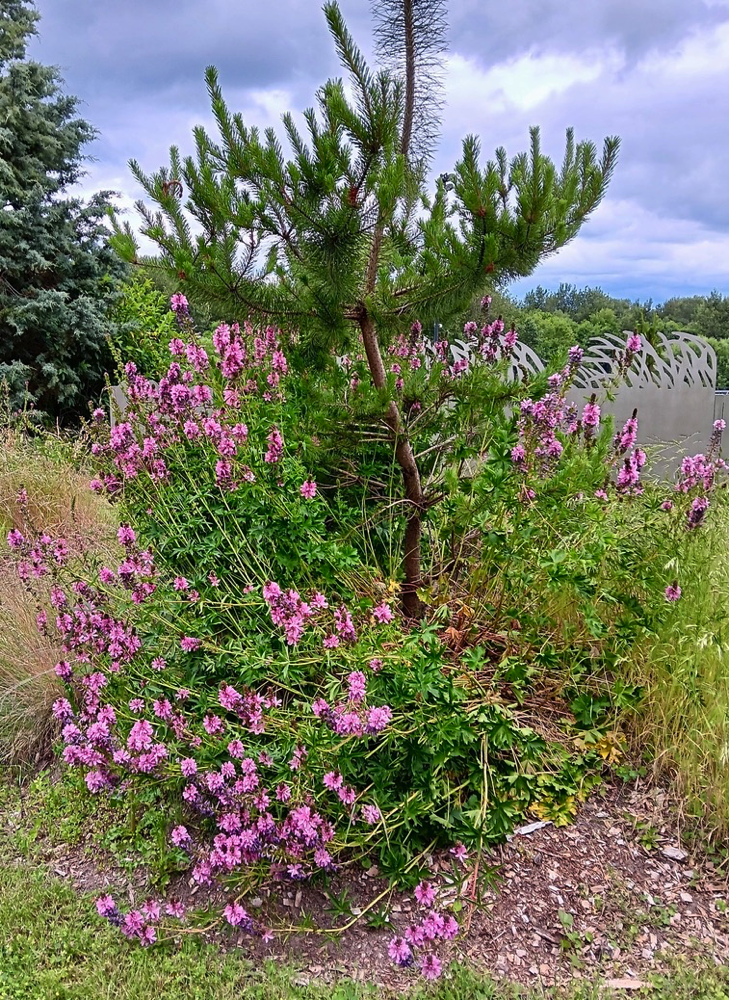 |
 |
by Marilee Henry
 |
 |
A riot in hot pink! That was my impression viewing this stunning bed of Henderson's checkermallow at the UW Bothell campus (above left). Once thought threatened in Washington, it is now available in many nurseries and plant sales, to the delight of native plant gardeners.
Henderson's checkermallow1 in its native habitat is found in western Washington near coastal tidelands, in marshes, and in wet meadows, with its range extending into southern British Columbia and south into parts of Oregon.
Henderson's checkermallow can grow to a maximum height of 5 to 6 feet, in summer sporting densely packed terminal clusters of bright pink blooms reminiscent of miniature hollyhocks. Each flower (~ 1 inch in width) has five shallowly-notched petals and numerous yellow stamens. Its leaves are alternate with palmate veining, the basal leaves being almost round but becoming more sharply lobed going up the stems. Though found in wet habitats in the wild, it is very adaptable to most PNW garden settings, needing only moderate watering in full sun. Tolerating a range of sandy to clay-rich soils, it can even thrive in salty environments - a great choice for coastal gardens. If grown in containers, use 5-gallon sizes or larger to accommodate its taproot.
The leaves and blossoms of this plant are edible and were an important food source for native peoples. They can be used cooked as in soups or raw in salads2. The flowers are pollinated by bumblebees, bees, beetles, hummingbirds and butterflies, including the endangered Fender's Blue Butterfly3. Six species of moth/butterfly use Sidalcea plants as larval hosts4.
This perennial can spread by rhizomes and is also easily grown from seeds, which mature about 3 to 4 weeks after the flowers have bloomed. Plant the seeds in the fall as for most of our native species, as they need cold stratification for germination.
Even if you are not harvesting seeds, please do not remove the stems after flowering! Henderson's checkermallow stems are hollow, making them prime nesting sites for native bees over the winter and for several years afterwards5. Instead, cut the stems to about 18 inches above the ground in the spring and forget them. New growth will soon hide them, and you will be providing nesting habitat for future generations of native pollinators!
Remember, "You are nature's best hope!" - Doug Tallamy, author of "Nature's Best Hope" and "Bringing Nature Home".
Marilee Henry
Kirkland Community Wildlife Habitat Team Member, Washington Native Plant Society (WNPS) Native Plant Steward, Green Kirkland Steward, Finn Hill Neighborhood Alliance Contributor
For more images, see https://burkeherbarium.org/imagecollection/taxon.php?Taxon=Sidalcea%20hendersonii
Ibid (Same as 2.)
How to leave stems for native bees: https://sites.tufts.edu/pollinators/2021/04/the-right-way-to-leave-stems-for-native-bees/#:~:text=Native%20plants%20like%20joe%2Dpye,in%20these%20actively%20growing%20stems.